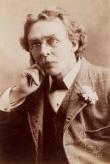In reviewing the premiere, the Empire's theatre critic accorded the overall production much praise, noting, in particular, Scott's intelligible plot, parodies, puns, and local hits, and the exceptionally good scenery produced by W. J. Wilson, 'a gentleman well-known to the Sydney public as a first-class scenic artist' (Empire 28 December 1874, p.3).
The story begins with Robinson Crusoe being torn from the arms of his betrothed, Polly, and press-ganged on the orders of Captain Will Atkins (who is also in love with Polly). With Crusoe aboard Atkin's ship, the demons Tyrant and Oppression, surrounded by their demonical slaves, hatch a plan to persecute him. Fortunately for Crusoe, Fairy Liberty manages to overhear the conspirators and 'in a pretty panorama shows how she will bring him safely through his troubles and dangers' (Empire 28 December 1874, p.3). When Crusoe is shipwrecked, he begins to lament his fate, but then meets up with four animals who not only keep him company but also help him survive. He later discovers footprints on the sand but, at almost the same time, he is discovered by a party of 'war-whooping' Sugeeans. His meeting with King Thackem-Whackem-boo and his sons Ratty Tim and Lanky Joe does not go well, and it is only through the intervention of Friday that Crusoe is saved from the Sugeeans' knives. Friday subsequently becomes Crusoe's head cook and handy man. In the meantime, Captain Atkins has also been wrecked upon the island and is in dispute with the islanders over his beautiful captive, Polly. When he finds out that Polly is on the island, Crusoe orchestrates a rescue and manages to defeat his foe in a terrific fight, thereby saving his beloved from both Atkins and the Sugeeans. The Fairy Liberty then manages to foil the evil plans of the demons Tyrant and Oppression by removing all the good people from danger and taking them to her own island home.
The incidents of the pantomime were played out in seven settings, a transformation and harlequinade:
Scene 1 The Old Jetty at Hull,
Scene 2 The Tyrant's Home (and Grand Panorama),
Scene 3 Bowers of Brilliant Beauty (and Grand Ballet),
Scene 4 The Island,
Scene 5 Crusoe's Hut,
Scene 6 The Lee Shore and Atkins' Wreck (and Grand Coconut Ballet),
Scene 7 The Island Home, and the Grand Transformation Scene.
Harlequinade - This was set in three scenes: Scene 1 A Well-known Street in the City, Scene 2 Somewhere in George Street, and Scene 3 The Grotto of Gloom.

